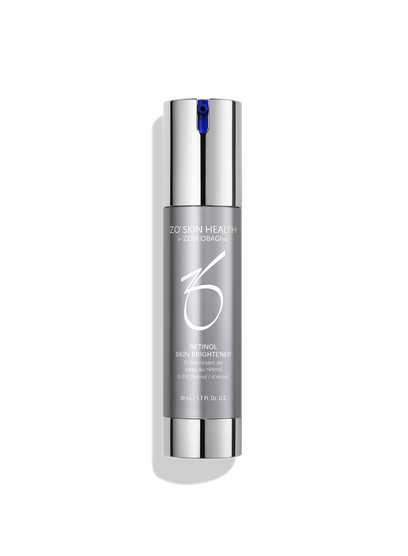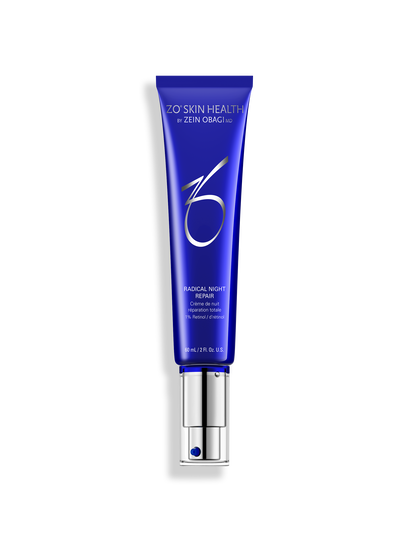Retinol for beginners: What it is and how to incorporate it into your routine
By ZO® Skin Health
Retinol is a game-changing skincare ingredient favored by many. Whether you’re aiming to smooth fine lines, combat acne, or even out your skin tone, it can become a key part of your skincare routine.
But for beginners, it’s important to know how to use retinol correctly to maximize its benefits. In this guide, we'll take you through everything you need to know to make it part of an effective skincare routine.
What is retinol?
Retinol is a powerful derivative of vitamin A. It's also a type of retinoid – one of the most common forms of retinoids available over-the-counter.
Prescription-strength retinoids, like tretinoin, are more potent but can only be prescribed by a healthcare professional. Retinol is milder than these, making it an excellent entry point for those who are considering introducing retinoids to their routine.
However, due to its potency, retinol should be introduced gradually into your routine to allow your skin time to adjust. Used improperly, it can cause irritation, redness, and flaking – especially for first-time users.
How does it work?
As part of a skincare routine, retinol has several functions and benefits:
- Promotes cell turnover: Retinol helps your skin shed old cells and generate new ones faster, leading to smoother, more radiant skin and an improved overall texture.
- Anti-aging: Retinol use aids healthy collagen + elastin. Over time, regular use of retinol can minimize the look of fine lines, wrinkles and sagging.
- Improve skin tone: Retinol can help to fade discoloration as well as sun damage. It can also exfoliate the skin, smoothing the texture.
- Clears pores: Retinol's exfoliation-boosting properties also help prevent pores from becoming clogged from dead skin cells sticking together, which in turn reduces breakouts.
Choosing the right retinol product
When selecting the best retinol serum or cream for beginners, you'll need to consider both the concentration and formulation. This will ensure you get the best results with minimal irritation.
Retinol products typically come in concentrations ranging from 0.25% to 1%. For beginners, it's important to start with a lower retinol percentage, such as 0.25%, to allow your skin time to adapt. Once your skin builds a tolerance, you can gradually increase the concentration if necessary. Those with more sensitive skin may find that they need to stick with a lower concentration permanently.
Retinol is available in various forms. Each has its benefits, depending on your skin type:
- Serums: These tend to be lightweight and are absorbed quickly into the skin. They are a great option for oily or combination skin types.
- Creams: Retinol creams are thicker and more hydrating, making them an excellent choice for dry or sensitive skin.
- Oils: Retinol oils are typically the most moisturizing and are ideal for those with very dry or mature skin.
When choosing your product, it’s important to look at the other ingredients included in the formulation. Many high-quality, medical-grade retinol products now include soothing ingredients like glycerin, squalane, or hyaluronic acid to help offset the dryness and irritation that retinol can sometimes cause.
Incorporating retinol into your routine
Adding retinol to your skincare routine requires a careful, gradual approach to minimize irritation and allow your skin to adapt. Follow these steps to ensure you incorporate it effectively:
- Start slowly: Begin by applying retinol two to three nights per week. As your skin builds tolerance, you can gradually increase the frequency. If your skin tolerates the product well after several weeks, you may work up to nightly use.
- Nighttime application: Retinol should be applied in the evening. Sunlight can degrade retinol, making it less effective, and it can also increase your skin's sensitivity to the sun.
- Layer correctly: After cleansing and fully drying your skin, apply a pea-sized amount of retinol to your face. Follow up with a moisturizer to help lock in moisture and mitigate dryness.
- Know how to pair with other ingredients: To get the best results, pair retinol with complementary ingredients. For example:
- Hyaluronic acid: This hydrating ingredient works well with retinol to replenish moisture.
- Niacinamide: Niacinamide with retinol is a great combination. Known for its soothing properties, niacinamide can help calm the skin and reduce redness.
- Always use sunscreen: One of the most important things to remember when using retinol is that it makes your skin more sensitive to UV rays. Apply a broad-spectrum sunscreen with at least SPF 350 every morning to protect your skin from sun damage.
Managing side effects
It’s normal to experience some side effects when you first start using retinol, especially dryness, redness, and peeling. These effects are part of the skin’s adjustment process and should subside after a few weeks. However, there are ways to manage these side effects to keep your skin comfortable:
- Moisturize generously: Using a good moisturizer will help keep your skin hydrated and reduce dryness. Look for products with soothing ingredients like ceramides, which help lock in moisture, glycerin, or squalane, which is a molecule that mimics the skin's ability to moisturize itself.
- Don't overuse: It may be tempting to apply retinol more often to see faster results, but overuse can lead to severe irritation. Stick to the recommended frequency, and only increase usage once your skin shows tolerance.
- Consider moisturizing first: Some beginners find that applying a moisturizer before retinol helps reduce irritation while your skin adjusts.
If side effects like peeling, stinging, or persistent redness continue after several weeks, consult a dermatologist. They may recommend switching to a gentler product or adjusting your application frequency.
Find the best retinol products for beginners with ZO®
If you're planning on introducing retinol to your routine, it may be worth considering a targeted approach – and ZO® can help. Our Authorized Physicians can take you through adding retinol. For general advice and regimen-based questions, meanwhile, you can use our Live Chat to speak to a Specialist.
For further advice, please get in touch with our friendly team of ZO® Skin Health experts.
Shop The Post
Retinol + Acne Complex

Oily + Acne-Prone Skin TSA Approved
Retinol Skin Brightener 0.5%
AM or PM All Skin Types Brightening
Radical Night Repair
All Skin Types Anti-Aging TSA Approved



